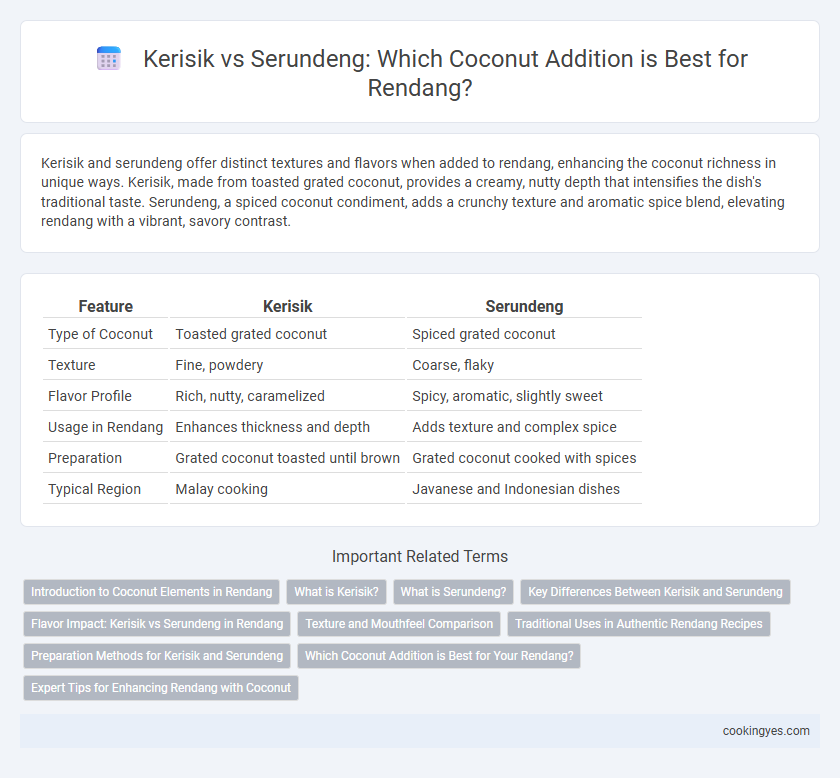Kerisik and serundeng offer distinct textures and flavors when added to rendang, enhancing the coconut richness in unique ways. Kerisik, made from toasted grated coconut, provides a creamy, nutty depth that intensifies the dish's traditional taste. Serundeng, a spiced coconut condiment, adds a crunchy texture and aromatic spice blend, elevating rendang with a vibrant, savory contrast.
Table of Comparison
| Feature | Kerisik | Serundeng |
|---|---|---|
| Type of Coconut | Toasted grated coconut | Spiced grated coconut |
| Texture | Fine, powdery | Coarse, flaky |
| Flavor Profile | Rich, nutty, caramelized | Spicy, aromatic, slightly sweet |
| Usage in Rendang | Enhances thickness and depth | Adds texture and complex spice |
| Preparation | Grated coconut toasted until brown | Grated coconut cooked with spices |
| Typical Region | Malay cooking | Javanese and Indonesian dishes |
Introduction to Coconut Elements in Rendang
Kerisik and serundeng are two distinct coconut-based ingredients used to enhance the rich flavor profile of rendang. Kerisik, made from toasted grated coconut ground into a smooth paste, adds a deep, nutty aroma and creamy texture that integrates seamlessly with the slow-cooked spices. Serundeng, on the other hand, consists of spiced, sauteed grated coconut flakes that impart a crunchy texture and a slightly caramelized sweetness, complementing the tender meat without overpowering the complex layers of traditional rendang.
What is Kerisik?
Kerisik is toasted grated coconut that adds a rich, nutty flavor and thickens the sauce in Rendang, enhancing its creamy texture. Unlike serundeng, which is spiced toasted coconut flakes used mainly as a garnish or side condiment, kerisik is ground finely to blend seamlessly into the dish. The use of kerisik intensifies the depth and authenticity of traditional Rendang by contributing both aroma and body to the slow-cooked meat.
What is Serundeng?
Serundeng is a traditional Indonesian condiment made from grated and toasted coconut mixed with aromatic spices such as garlic, coriander, and galangal, creating a flavorful and slightly crunchy texture. Unlike kerisik, which is coconut toasted and ground into a paste to thicken and enrich dishes like rendang, serundeng serves as a dry, spicy topping or side that adds a distinct nutty and savory flavor. Its role in rendang is often complementary, providing contrast with kerisik's creamy consistency and enhancing the overall coconut profile of the dish.
Key Differences Between Kerisik and Serundeng
Kerisik and serundeng both enhance rendang with toasted coconut but differ in texture and flavor concentration. Kerisik is finely ground toasted coconut, lending a smooth, rich, and slightly sweet nutty flavor that blends seamlessly into the sauce. Serundeng consists of coarsely grated, spiced, and toasted coconut flakes, offering a crunchier texture and a pronounced aromatic seasoning that adds complexity to the dish.
Flavor Impact: Kerisik vs Serundeng in Rendang
Kerisik, a toasted grated coconut paste, imparts a rich, nutty depth and creamy texture that enhances Rendang's savory profile with subtle caramelized notes. Serundeng, made from spiced, toasted shredded coconut, adds a drier, crisp texture and a pronounced aromatic spice blend, creating a complex, layered flavor. The choice between kerisik and serundeng significantly alters Rendang's taste by balancing creaminess against spice-forward crunchiness.
Texture and Mouthfeel Comparison
Kerisik, a toasted grated coconut paste, offers a rich, smooth, and creamy texture that enhances rendang's mouthfeel with a slightly oily, nutty consistency. In contrast, serundeng consists of spiced, toasted shredded coconut that introduces a coarser, crunchy texture, adding a distinct bite to each mouthful. The choice between kerisik and serundeng directly influences rendang's overall texture, with kerisik providing silkiness and serundeng delivering a textured, layered experience.
Traditional Uses in Authentic Rendang Recipes
Kerisik, a toasted coconut paste, is traditionally used in authentic Rendang recipes to impart a rich, nutty flavor and creamy texture, enhancing the dish's depth and complexity. Serundeng, made from spiced and sauteed grated coconut, is more commonly served as a garnish or side, providing a crunchy contrast rather than being an integral part of the cooking process. Authentic Rendang relies primarily on kerisik for the coconut element to achieve its signature thick, luscious sauce characteristic of Minangkabau cuisine.
Preparation Methods for Kerisik and Serundeng
Kerisik is prepared by toasting grated coconut until golden brown, then grinding it into a fragrant, coarse paste that adds a nutty depth to rendang. Serundeng, on the other hand, involves sauteing grated coconut with spices like turmeric and chili until dry and crumbly, creating a textured, spicy topping. The distinct preparation methods of kerisik and serundeng define their unique contributions to the rich flavor and texture profile of rendang.
Which Coconut Addition is Best for Your Rendang?
Kerisik, made from toasted grated coconut, imparts a rich, nutty flavor and thickens Rendang's sauce, enhancing its creamy texture. Serundeng, on the other hand, consists of spiced, sauteed coconut flakes that add a crunchy texture and aromatic depth to the dish. For a traditional, velvety Rendang, Kerisik is preferred, while Serundeng suits those seeking an added layer of spice and texture.
Expert Tips for Enhancing Rendang with Coconut
Expert tips for enhancing rendang emphasize choosing between kerisik and serundeng based on texture and flavor intensity; kerisik, made from toasted ground coconut, adds a rich, nutty depth, while serundeng offers a coarser texture with aromatic spices that complement the dish's complexity. Use kerisik for a smoother, creamier coconut profile that melds seamlessly with the slow-cooked beef, enhancing the sauce's thickness and flavor. Incorporate serundeng to introduce a crunchy contrast and a balanced, spiced coconut note, ideal for garnishing and elevating the rendang's overall sensory experience.
Kerisik vs Serundeng for coconut addition Infographic

 cookingyes.com
cookingyes.com